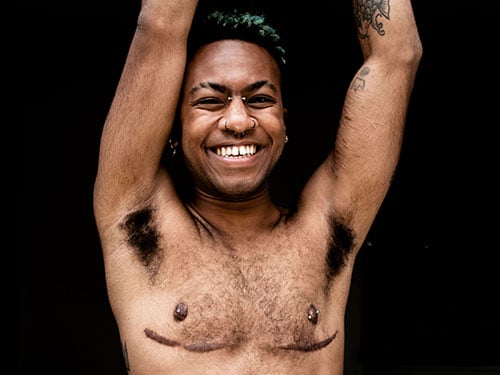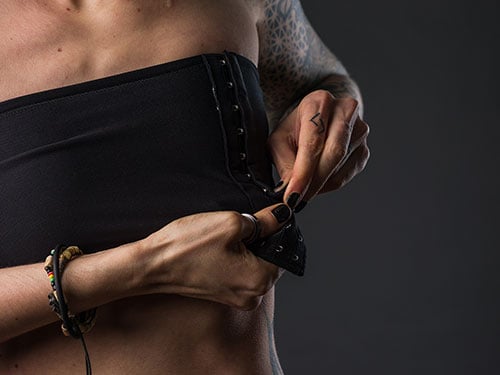Understanding skin changes from social transitioning
For many transgender, non-binary, and gender diverse people, social transitioning is a process in which they make changes their gender expression, and how they move through the world, to align their day-to-day experience in ways that affirm their gender identity.
There are more ways people explore their physical gender expression than we can list, but when it comes to those relating to skin it can include practices like: binding, tucking, packing, body modifications, exploring make-up, and hair removal techniques such as shaving, plucking, and tweezing. Each non-medical technique carries its own potential for skin-related changes, discomfort and challenges, but with knowledge and care, these skin developments can be managed effectively.
We’ve funded research and worked closely with leading experts in transgender healthcare to create a guide on what skin conditions may be experienced from social transitioning.
This research dived into published studies of skin conditions that may occur during the transition journey. After screening over 500 research papers and following a robust quality assessment, this study evolved into a paper, which signposts to the most reported skin changes during different stages of transition. We appreciate this may mean that there are some limitations in the article, including age and ethnic groups.
Transition journeys are very much an individual experience, and some symptoms may be experienced that don’t appear here, and some that are included in the article may not be experienced at all. These limitations are here due to the very limited research which has been done in this space to date. This is why we feel it is important to provide more resources and information for those who may need it.
What is social transitioning?
Social transitioning methods can allow trans+ individuals to explore and express their gender identity in ways that don’t require surgery or hormone treatments. These changes can help an individual to achieve a desired appearance, social presentation, and societal perception – often playing a crucial role in daily gender expression and identity affirmation.
Chest binding
Chest binding involves compressing chest tissue to create a flatter appearance, often using commercial binders, elastic bandages, or other compression materials.
What skin concerns can arise with chest binding?
Regular chest binding can lead to skin concerns such as acne, itching, skin infection, swelling and scarring (Huang et al., 2022)1 . Tight binding materials can restrict skin airflow which may increase the likelihood of acne and irritation, while pressure and prolonged skin contact may also cause itching and swelling.
In a survey of 1800 individuals who had ever used chest binding, 33% experienced acne and 45% experienced itching within the first year of using the technique (Peitzmeier et al., 2021)2 .
Long-term binding can also affect skin elasticity, which is an important consideration for those planning chest surgery in the future. However, there are many articles and resources on safe binding written by the community that can be found online.
1. Huang, C., Gold, S., Radi, R., Amos, S., & Yeung, H. (2022). Managing dermatologic effects of gender-affirming therapy in transgender adolescents. Adolescent Health, Medicine and Therapeutics, 13, 93–106. https://doi.org/10.2147/AHMT.S344078
2. Peitzmeier, S. M., Silberholz, J., Gardner, I. H., Weinand, J., & Acevedo, K. (2021). Time to first onset of chest binding-related symptoms in transgender youth. Pediatrics, 147(3), e20200728. https://doi.org/10.1542/peds.2020-0728
Tucking
Tucking is the practice of carefully positioning the penis and or testicles and using compression garments or other materials to push them back towards the body, creating a smoother and more feminine appearance. It’s a common practice, with 70% of transgender women reporting using the technique (Poteat et al., 2018)3 .
What skin concerns can arise with tucking?
Tucking can create prolonged pressure and reduce airflow to the groin area. The technique may lead to skin issues such as itching, rash, and skin infections. In a study, 28% of individuals who practiced tucking reported experiencing itching and 21% reported rashes (Poteat et al., 2018)4 .
It’s important for those who tuck regularly to be aware of their skin’s health and consult healthcare professionals if issues arise.
3. Poteat, T., Malik, M., & Cooney, E. (2018). 2148 Understanding the health effects of binding and tucking for gender affirmation. Journal of Clinical and Translational Science, 2(Suppl. 1), 76. https://doi.org/10.1017/cts.2018.268
4. Poteat, T., Malik, M., & Cooney, E. (2018). 2148 Understanding the health effects of binding and tucking for gender affirmation. Journal of Clinical and Translational Science, 2(Suppl. 1), 76. https://doi.org/10.1017/cts.2018.268
Packing
Packing involves using materials or specialised devices to create the appearance of a bulge in the groin area, which can be an important aspect of gender expression for many individuals.
What skin concerns can arise with packing?
Similarly to tucking, packing can lead to skin irritation, including itching and rashes (Malik et al., 2024)5 . This may often be due to the prolonged contact of the packing materials with the skin, combined with potential reduction in airflow to the groin area. If facing skin challenges while packing, consulting with a healthcare professional may provide guidance on the best materials to use and general practices to help limit irritation.
5. Malik, M., Cooney, E. E., Brevelle, J. M., & Poteat, T. (2024). Tucking Practices and Attributed Health Effects in Transfeminine Individuals. Transgender Health, 9(1), 92–97. https://doi.org/10.1089/trgh.2022.0064
Hair Removal
Hair removal, including shaving, plucking, and tweezing, is a common practice for many seeking to align their appearance with their gender identity. It involves the removal of body or facial hair to achieve a smoother skin surface, and preferred aesthetic.
What skin concerns can arise with hair removal?
Hair removal, through shaving, plucking, or tweezing, disrupts the skin’s surface and may lead to irritation and rashes. Hair removal methods can cause minor skin trauma, remove protective oils, and provoke inflammation, making the skin vulnerable to irritation. When using these methods, it may help to seek advice on gentle skin care and hygiene practices to help reduce skin irritation and issues.
Feeling Comfortable in Your Skin
Experiencing changes to skin at any time can be both euphoric and uncomfortable. With knowledge on what changes may happen, and where to seek support, we hope to bring comfort back to skin, as quickly as possible.
Everyone’s body reacts differently, so if you’re currently going through or considering social transitioning, doing research and/or talking to a healthcare professional is the best way to find solutions that are safe and effective for you.
Understanding skin changes from…


Oestrogen and Anti-androgen therapy

Gender affirming surgery










